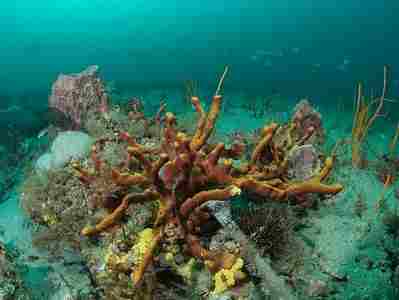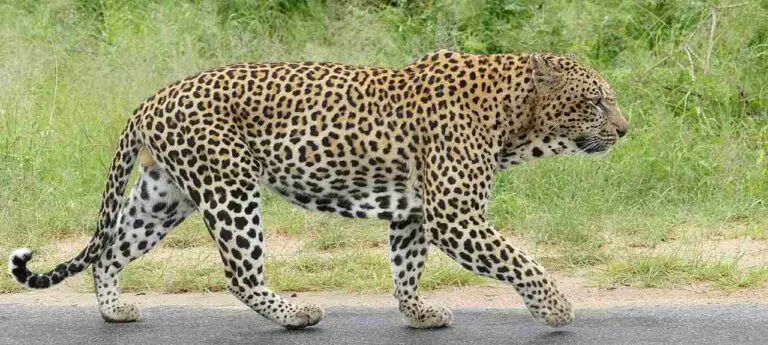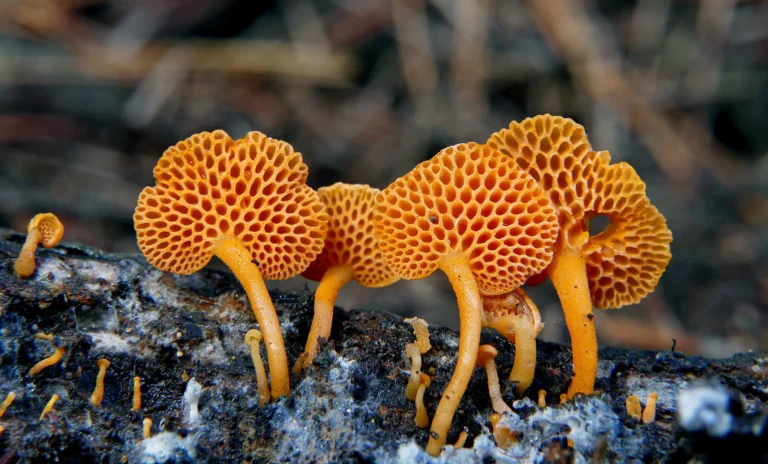Energy Pyramid of the Tropical Rainforest and Its Components
The energy pyramid of the tropical rainforest consists of producers, primary, secondary, tertiary and quaternary consumers, as well as decomposers and the processes/interactions leading to energy transfer and losses in the ecosystem.
This article discusses the energy pyramid of the tropical rainforest, as follows;
1). Tropical Rainforest Producers (as part of the Energy Pyramid of the Tropical Rainforest)
Tropical rainforest producers are autotrophic organisms, including mainly plants, that are crucial to the natural sequence of energy transfer and conservation within the ecosystem.
These organisms constitute the foundation of the food web, and are responsible for capturing and transforming solar energy (in the form of light) into organic biomass, through photosynthesis [2].
Role of Tropical Rainforest Producers
The role of producers in the energy pyramid of the tropical rainforest, includes; photosynthetic biomass-production, food provision, energy transfer, habitat creation, and carbon sequestration. These are discussed below;
1). Photosynthetic biomass production is carried out by tropical rainforest producers, including vascular and non-vascular plants like trees, herbaceous plants, and mosses.
These producers utilize sunlight, carbon dioxide and water to carry out photosynthesis.
The photosynthetic process allows autotrophs in forests to produce energy stored in the form of carbohydrate compounds, as well as oxygen, both of which are essential for their own survival and growth.
2). Rainforest producers serve as the primary source of food for herbivores, such as some mammals, birds and insects, in the tropical rainforest.
They provide the nutrients and energy which these animals require to thrive.
3). Energy transfer is initiated by producers, which convert solar energy into usable chemical energy that can be assimilated by other living organisms.
This chemical energy is transferred through the food chain as herbivores feed on producers, and subsequently fall prey to carnivores and omnivores.
4). Habitat creation in rainforests is also a function of producers like trees; which form a complex assemblage of low-level and arboreal microhabitats [6].
These plants form the different layers of the forest structure, including the canopy, understory, and forest floor, and provide shelter as well as food resources for a wide array of organisms.
5). Tropical rainforest producers contribute immensely to carbon sequestration, by absorbing carbon dioxide from the atmosphere during photosynthesis and utilizing it for the production of biomass.
Producers are mostly responsible for the status of rainforests as prominent natural carbon sinks [5].
Their growth and photosynthesis, help reduce both the rate and effects of climate change, by reducing atmospheric concentrations of greenhouse gases.

Concept and Causes of Energy Loss During Transfer
The transfer of bioenergy between trophic levels in the tropical rainforest, is not a 100% efficient process, as energy losses occur in each level and phase of transfer.
Causes of energy loss during transfer include factors like organic waste production, digestion inefficiency, and metabolic heat losses. These and others are highlighted in the list below;
1). Some energy is lost by producers, to the process of biodegradation.
When autotrophic organisms die in the tropical rainforest, their remains are typically broken down by decomposers, such as bacteria and fungi [3]. In the process of microbial decomposition, some chemical energy in the plant substrate is released as heat and lost from the energy pyramid.
2). Digestion inefficiency is a possible cause of energy loss or wastage from producers.
This is because not all parts of the plants are digestible to herbivores, or can be transformed into usable energy. Some of such undigested material is excreted as waste without any contribution to the herbivore's cells, thereby resulting in energy loss.
3). Respiration and other metabolic processes can cause organisms to use-up some of the energy obtained directly or indirectly from plants. This energy is lost as heat and is unavailable for reproduction or growth.
4). Further up the trophic hierarchy, predator-prey relationships can contribute to energy losses in the effort to capture prey, elude predators, or consume food. Such losses can be traced back to producers, since they are the primary source of food and energy resources in the tropical rainforest.
Overview of Producers in the Energy Pyramid
Producers occupy the basal level (Trophic Level 1) at the bottom of the energy pyramid, as they are the primary source of nutrients/energy for the entire organic community.
Examples of producers in the tropical rainforest are
1. Rubber Trees (Hevea brasiliensis)
2. Kapok Trees (Ceiba pentandra)
3. Mahogany Trees (Swietenia spp.)
4. Ferns
5. Bromeliads
6. Orchids
The source of energy for producers in the tropical rainforest is sunlight, which they use to facilitate the synthesis of organic compounds and oxygen from inorganic raw materials.
Producers survive through energy storage in their tissues; a function that also allows them to serve as the primary producers and support the entire energy pyramid of the tropical rainforest.
2). Tropical Rainforest Primary Consumers
Tropical rainforest primary consumers are a group of herbivorous feeders that play a major role in the complex process of energy transfer and conservation within the ecosystem.
They obtain their own energy by feeding on producers (including herbaceous plants, mosses, twigs, roots, seeds and fruits) and in turn serve as a food source for secondary consumers.
Role of Tropical Rainforest Primary Consumers
The role of tropical rainforest primary consumers in the energy and biomass pyramids, is based on herbivory, and can be said to comprise of energy transfer, food provision for predators, and contribution to local biodiversity.
1). Primary consumers exhibit herbivory by feeding mainly on vegetation, including plant leaves, fruits, flowers and seeds.
They contribute to the control of plant populations and play a key role in shaping the trophic structure of the rainforest ecosystem.
2). The consumption of producers by primary consumers signifies the onset of energy transfer in the tropical rainforest.
Energy stored in plant tissues is caused to flow up the food chain by herbivores that consume these tissues, and serve as prey for non-herbivores. This energy is used by the primary consumers, and subsequently also by higher consumers, for their growth, survival and reproduction.
3). Food provision is also a function of primary consumers, which serve as the primary source of food for secondary consumers, including carnivores and omnivores.
Their health and abundance of herbivores are vital for sustaining predatory organisms in tropical rainforests, and for maintaining a functional, balanced ecosystem.
4). Biodiversity is also promoted by the herbivorous primary consumers, which contribute to population abundance, species richness, and ecological balance of the rainforest.
Concept and Causes of Energy Loss During Transfer
The causes of energy loss from/by primary consumers in tropical rainforests, are generally identical to those for primary producers. They include general metabolism, digestion inefficiency, decomposition and waste production.
Examples of primary consumers in the tropical rainforest are;
1. Sloth
2. Squirrel Monkey
3. Howler Monkey
4. Leafcutter Ant
5. Fruit Bat
6. Toucan
7. Tapir
8. Macaw
9. Agouti
These organisms depend on plants as their main source of food, and serve as a crucial link in the transfer sequence, within the tropical rainforest energy pyramid. It must be however noted that some of them occasionally exhibit omnivorous behavior by consuming non-plant materials like insects. Such tendencies are only indicative of the highly diverse, variable and adaptive nature of tropical rainforest communities.

3). Tropical Rainforest Secondary Consumers (as part of the Energy Pyramid of the Tropical Rainforest)
Tropical rainforest secondary consumers are carnivores or omnivores that are part of rainforest biodiversity, and contribute to energy transfer and conservation alongside other organic groups within the ecosystem.
They survive mainly by preying on herbivorous primary consumers, and are often susceptible to predation by the higher tertiary (and quaternary) consumers.
Role of Tropical Rainforest Secondary Consumers
Secondary consumers exhibit carnivory and omnivory by feeding on primary consumers, like herbivorous reptiles, birds, insects and mammals. Omnivorous secondary consumers may also include plant material like fruits in their diet.
By feeding on primary consumers, secondary consumers transfer the stored energy in the herbivores' tissues, further up the food chain.
Regulation of primary consumer populations is another function of secondary consumers.
When they prey on primary consumers, carnivores and omnivores indirectly influence the abundance of plant species, and help to maintain a balanced ecosystem.
For apex predators, secondary consumers are often an important food source, along with primary consumers.
Concept and Causes of Energy Loss During Transfer, for Secondary Consumers in the Rainforest Energy Pyramid
As energy flows up the trophic levels in the food web, there is a decrease in the total amount of that is available to each successive level.
Energy losses occur during transfer to secondary consumers from primary consumers, as well as from secondary consumers to tertiary consumers.
The causes of energy loss from secondary consumers in the energy pyramid of the tropical rainforest, include; locomotion, respiration, indigestible food materials, and other metabolic phenomena.
Examples of secondary consumers in the tropical rainforest include;
1. Civet
2. Genet
3. Owl
4. Spider monkey
5. Ocelot

Consumption of Rainforest Secondary Consumers by Tertiary Consumers
Tertiary and quaternary consumers, which are the apex predators, may consume secondary consumers.
Tertiary consumers are above secondary consumers in the energy pyramid of the tropical rainforest ecosystem, by reason of biological advantages of speed, size, sensitivity, and/or hunting skill; which make them 'superior' as predators.
It also implies that tertiary consumers are likely to be more successful in capturing prey among primary consumer populations, than the secondary consumers.
The source of energy for secondary consumers is sunlight, but unlike primary consumers that gain this energy by feeding on plant materials, secondary consumers must feed on animal materials (mostly derived from primary consumers) to survive.
Predation by and on secondary consumers, contributes to energy flow in the rainforest ecosystem.
4). Tropical Rainforest Tertiary Consumers
Tertiary consumers in the tropical rainforest are high-level predators that occupy the fourth trophic level in the food web or chain.
As predators, these organisms are involved in regulating the population(s) of secondary consumers and other organisms in lower trophic levels.
Role of Tropical Rainforest Tertiary Consumers
Tertiary consumers are advanced predators, and are not highly susceptible to predation themselves.
They occupy the upper region of the energy pyramid and play a major role in controlling the population sizes of species in lower trophic levels, like other predatory organisms.
This mean that tertiary consumers can prevent overpopulation, and its consequences including overgrazing and general resource-depletion in the ecosystem.
Tertiary accumulate energy from their prey into their own biomass, which can be transferred away from them to other trophic levels by means of scavenging, decomposition and predation, among other mechanisms.
Through their presence and feeding-activities; tertiary consumers helps in maintaining local biodiversity, by preventing the dominance of any single specie or group of organisms, in the ecosystem.
Concept and Causes of Energy Loss by Tertiary Consumers in the Tropical Rainforest
Energy loss during trophic transfer occurs at every level of the energy pyramid, including that which is occupied by tertiary consumers.
The most common avenues of energy loss for these organisms are respiration, locomotion and general metabolism. These processes cause some of the energy obtained from prey to dissipate as heat.
Indigestion and excretion are also causes of energy loss by tertiary consumers, in the energy pyramid of the tropical rainforest. Biomass that is ejected as a result of these processes, becomes lost as waste-energy.
Upon the deaths of tertiary consumers, their biomass becomes substrate for decomposers, which act upon them and break them down to simpler products.
Competition against other tertiary consumers can cause energy expenditure and wastage of prey-biomass, as well as injury or death; which can all lead to some form of energy loss.
Examples of Tertiary Consumers in the Amazon Rainforest
Examples of tertiary consumers in the Amazon rainforest are;
1. Caiman
2. Amazon river dolphin
3. Giant otter
4. Spectacled owl
These animals are listed here as tertiary because of the inclusion of a fifth trophic level (quaternary consumers) in this article. In a four-level energy pyramid, they will be at the topmost level alongside other apex predators, some of which are classified as 'quaternary' here.
In the Amazon rainforest, quaternary consumers may include; green anaconda (Eunectes murinus), jaguar (Panthera onca), and harpy eagle (Harpia harpyja).

5). Tropical Rainforest Quaternary Consumers (as part of the Energy Pyramid of the Tropical Rainforest)
Quaternary consumers are predatory organisms that occupy the highest trophic level in the energy pyramid of the tropical rainforest.
They are apex predators and generally have no predators above them within their environment.
Quaternary consumers play a key role in regulating the population of primary, secondary and tertiary consumers, as well as in the overall flow and conservation of energy within the ecosystem.
Role of Tropical Rainforest Quaternary Consumers
Quaternary consumers are dominant predators at the top of the food chain, that regulate the populations of other consumers and contribute to overall ecosystem-equilibrium.
Population control is carried out by quaternary consumers when they prey on lower consumers to gain energy. This type of biological control is a natural tool by which the rainforest ecosystem prevents overexploitation and depletion of its resources.
Energy obtained when quaternary consumers feed on lower organisms, is accumulated in the apex trophic level, where it is utilized for reproduction and growth.
Lastly, quaternary consumers also play a part in maintaining regional biodiversity in the tropical rainforest, by preventing unsustainable population growth of their prey-species; so that competition in lower trophic levels is kept at sustainable levels that still allow for (and even facilitate) diversification and coexistence.
Quaternary Consumers and The Concept and Causes of Energy Loss During Transfer
Energy loss during trophic transfer occurs at each level of the food web, including the fifth (quaternary consumer) trophic level.
Quaternary consumers lose energy by the same mechanisms and causes responsible for energy losses in other predators. These include indigestible food materials, excretion, locomotion, respiration, and decomposition upon death of the organism.
Tropical Rainforest Decomposers and their Contribution to Energy Dynamics
Decomposers in tropical rainforests play are part of the organic community in the energy pyramid; meaning that they are involved in the energy dynamics of the ecosystem.
These organisms are primarily responsible for the breakdown of organic matter, such as remains of dead animals and plants, into simpler compounds, in such a manner that releases essential nutrients back into the soil [7].
Their activities lead to the recycling of energy within the ecosystem.
*Role of Tropical Rainforest Decomposers
In the energy pyramid of the tropical rainforest ecosystem, decomposers contribute to energy flow by means of various ecological roles which they play. Some of these ecological roles are; organic matter-breakdown, nutrient recycling, soil enrichment, energy transfer, and symbiosis.
They are discussed summarily below;
Decomposers like fungi, bacteria, and detritivores, are responsible for breaking down complex organic matter to yield simpler compounds through the process of biodegradation.
Materials which they break down include dead leaves, excrement, and animal carcasses.
Nutrients such as phosphorus; nitrogen and carbon are all released from decomposed organic matter. These nutrients are reused for the growth of plants and other primary producers in the rainforest, which subsequently serve as food for consumers.
Soil enrichment in tropical rainforests, is an outcome of the breakdown of organic matter by decomposers. As decomposers convert organic biomass into nutrient-rich humus, it enhances soil fertility, supporting the growth of trees, herbaceous plants and other autotrophs.

Decomposers contribute indirectly to the flow of energy up the pyramid, by enabling the recycling of energy-rich biomass within the ecosystem. When they breakdown organic matter, decomposers release energy which is then utilized by other organisms.
Some decomposers in tropical rainforests, form symbiotic relationships with plants.
An example of such decomposers is arbuscular mycorrhizal fungi [1]. The symbiotic relationships facilitate nutrient absorption by plants and improve their ability to access water in the soil, and other essential elements.
Contribution of Rainforest Decomposers to Energy Dynamics
The contribution of decomposers in energy dynamics can be traced to their ecological roles in the rainforest, and are essential for maintaining the overall functioning and health of the ecosystem.
Decomposers help to recycle energy by breaking down organic matter and releasing its constituents back into the ecosystem. This function ensures that energy is not locked-up or lost, but remains available for use by other organisms.
Nutrient availability is a means by which decomposers support the energy pyramid of the tropical rainforest.
From organic substrates, decomposers release nutrients that are essential for the productivity of primary producers. Because all heterotrophic organisms depend on producers, this availability of nutrients sustains the flow of energy throughout the ecosystem.
Ecosystem balance is sustained by decomposers which prevent the accumulation of organic matter from excrement and organic remains. In the absence of decomposition, this material could accumulate and foster the growth of pathogens, while restricting the circulation of nutrients.
Biodiversity is also supported by decomposers.
This is because the efficient degradation of organic matter by decomposers, supports a diverse array of animal and plant species that require nutrients for their survival. The presence of such biodiversity contributes to the overall stability and resilience of the rainforest ecosystem.
Trophic Transfer Efficiency and 90% Energy-Loss in Tropical Rainforest Energy Pyramids
Trophic transfer efficiency (TTE) is an important concept that describes the efficiency of energy transfer between trophic levels in a biome [4].
It quantifies the amount of energy transferred from one trophic level to the next, and it can be used to understand the process of energy flow, conversion, and loss in natural ecosystems.
In tropical rainforests, the concept of trophic transfer efficiency is particularly important because of the high biodiversity and complexity of the biome; which include multiple interactions occurring continuously between organisms.
It must be noted that the efficiency of energy transfer between trophic levels in tropical rainforests is low compared to other ecosystems; implying that significant energy losses are rather common as we move up the energy pyramid.
Below is an overview of the levels through which energy flows in tropical rainforests;
The energy pyramid in a tropical rainforest illustrates energy distribution among different trophic levels.
In the basal level (at the bottom) of the pyramid are the producers, including vascular plants and mosses, which capture solar energy and convert it to biomass during photosynthesis.
As energy flows through the trophic hierarchy, it is passed on to primary consumers (herbivores), then to secondary consumers (carnivores or omnivores), and finally to tertiary and quaternary consumers (apex predators).
In the process of energy flow across the trophic levels outlined above, there is a loss of energy through various processes, such as incomplete digestion, respiration, and locomotion.
The energy lost at each trophic transfer is usually significant, and estimated to be around 90%. This implies that only about 10% of the energy from one trophic level is transferred successfully to the next trophic level for organic consumption.
*Implications of Losses in the Energy Pyramid of the Tropical Rainforest
The 90% energy loss in tropical rainforest energy pyramids has several implications, some of which are discussed in this section.
Due to the high rate of energy loss, the amount of energy that is available to support higher trophic levels (such as apex predators) is limited. Accordingly, the abundance, diversity and spatial distribution of high-level consumers are low compared to lower categories.
Producers like plants play a vital role in sustaining energy flow within the rainforest ecosystem.
Energy losses increase the need for high productivity among these organisms, since they are the energy-foundation of the forest habitat.
Complex food webs are also to blame for the 90% energy loss in tropical rainforests.
This is because the presence of multiple, interconnected links between organisms creates more avenue for food and energy wastage.
It can also be argued that the complexity of the rainforest food web is a result of inefficient energy transfer, which causes organisms to adopt diverse adaptive behaviors, trophic relationships and food sources in order to compensate for the limited transfer-efficiency.
The complex food web and trophic interactions between species indeed compensate for energy losses, and contribute to the overall sustainability and resilience of tropical rainforest ecosystems.
There are implications of energy loss in rainforests, which include the need for conservation of primary producers, and for high productivity, in order to support consumers.
Conclusion
Energy pyramid of the tropical rainforest comprises of;
1. Tropical Rainforest Producers
2. Tropical Rainforest Primary Consumers
3. Tropical Rainforest Secondary Consumers
4. Tropical Rainforest Tertiary Consumers
5. Tropical Rainforest Quaternary Consumers
.. as well as Tropical Rainforest Decomposers and their Contribution to Energy Dynamics
References
1). Alexander, I. J.; Lee, S. S. (2005). "Mycorrhizas and ecosystem processes in tropical rain forest: implications for diversity." Biotic Interactions in the Tropics (pp.165-203). Available at: https://doi.org/10.1017/CBO9780511541971.008. (Accessed 3 August 2023).
2). Green, J. K.; Gentine, P.; Berry, J. A.; Zhang, Y.; Ciais, P. (2020). "Amazon rainforest photosynthesis increases in response to atmospheric dryness." Science Advances 6(47):eabb7232. Available at: https://doi.org/10.1126/sciadv.abb7232. (Accessed 3 August 2023).
3). Griffiths, H. M.; Ashton, L. A.; Parr, C. L.; Eggleton, P. (2021). "The impact of invertebrate decomposers on plants and soil" New Phytologist 231(6). Available at: https://doi.org/10.1111/nph.17553. (Accessed 3 August 2023).
4). Mehner, T.; Attermeyer, K.; Brauns, M.; Brothers, S. M.; Hilt, S.; Scharnweber, K.; van Dorst, R. M.; Vanni, M. J.; Gaedke, U. (2022). "Trophic Transfer Efficiency in Lakes." Springer, Ecosystems 25(8):1-25. Available at: https://doi.org/10.1007/s10021-022-00776-3. (Accessed 3 August 2023).
5). Soepadmo, E. (1993). "Tropical rain forests as carbon sinks." Chemosphere 27(6):1025–1039. Available at: https://doi.org/10.1016/0045-6535(93)90066-E. (Accessed 3 August 2023).
6). Wardhaugh, C. W.; Stork, N.; Edwards, W. (2013). "Canopy invertebrate community composition on rainforest trees: Different microhabitats support very different invertebrate communities." Austral Ecology 39(4). Available at: https://doi.org/10.1111/aec.12085. (Accessed 3 August 2023).
7). Zheng, Z.; Shanmughavel, P.; Sha, L.; Cao, M.; Warren, M. W. (2006). "Litter Decomposition and Nutrient Release in a Tropical Seasonal Rain Forest of Xishuangbanna, Southwest China1." Biotropica 38(3):342 - 347. Available at: https://doi.org/10.1111/j.1744-7429.2006.00151.x. (Accessed 3 August 2023).












